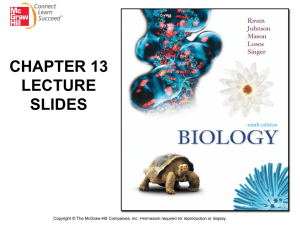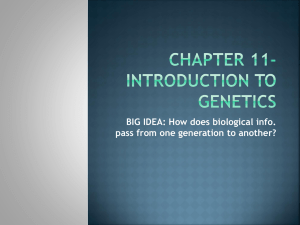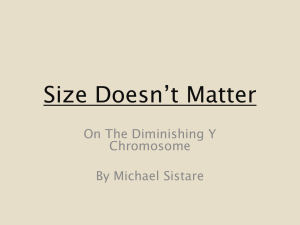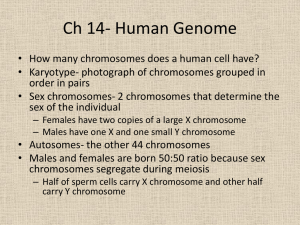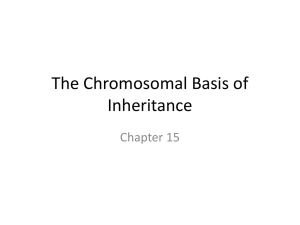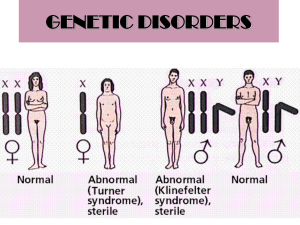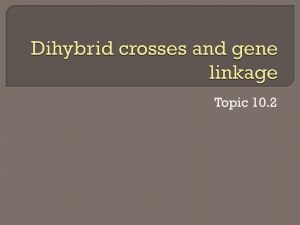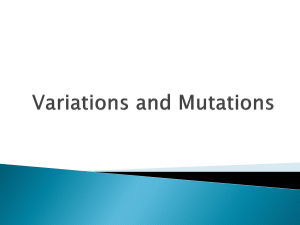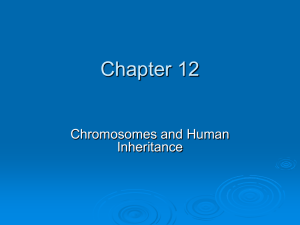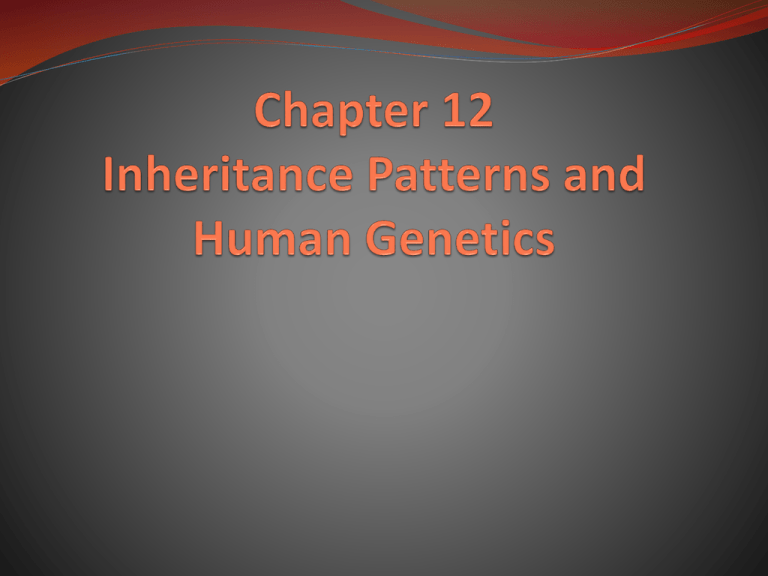
Thomas Hunt Morgan – (early 1900’s)
- Worked with Drosophila (fruit flies).
- Discovered sex chromosomes (X and Y)…Y is shorter than X in
length.
- Females = XX Males = XY
- Male gametes (sperm cells) determine the sex of offspring.
- Offspring – 50% male : 50% female.
- Also discovered “sex linkage”.
Sex Linkage = presence of a gene on a sex chromosome.
- X-linked genes – found on X chromosome.
- Y-linked genes – found on Y chromosome.
** Read pg. 222.
Sign of an X-linked trait – the trait inherited is recessive and it is
mostly all males that inherit it. Exs. Baldness, color blindness.
Linkage Group – 2 or more genes located on the same
chromosome = “Linked Genes”.
Linked Genes – because they are on the same chromosome,
they tend to be inherited together. Ex. Freckles and red
hair are often inherited together.
“Crossing Over” – during meiosis can separate linked
genes. See fig. 12-4 on pg. 223.
Chromosome Map – shows the linear sequence of genes on
a chromosome. “Crossing Over” frequency is used to
determine gene sequence. See fig. 12-5 on pg. 224.
Map Unit – 2 genes that are separated by crossing over 1%
of the time are considered 1 map unit apart.
Alfred Sturtevant (1 of Morgan's students) – used crossing
over data to construct a chromosome map of Drosophila.
In recent years – new techniques of gene mapping
(DNA sequencing) have been developed. Mapping is
now much faster and more accurate.
Germ-cell Mutations – occur in an organism’s
gametes/reproductive cells/germ cells. These
mutations do NOT affect the organism itself, but may
affect the offspring. Ex. Spina Bifida
Somatic Cell Mutations – occur in an organism’s body
cells and may affect the organism itself. These are not
passed on to offspring. Ex. skin cancer.
Lethal Mutations – cause death before birth.
NOTE – Some mutations can be beneficial. Ex. A
mutation that gives someone resistance to a particular
virus.
Chromosome Mutations
Chromosome Mutations – Either changes the structure of a
chromosome , OR the loss of an entire chromosome.
1. Deletion – loss of a piece of chromosome due to breakage.
2. Inversion – segment of chromosome breaks off and then
reattaches to the SAME chromosome, but in reverse orientation.
3. Translocation – a piece of chromosome breaks off and
reattaches to a DIFFERENT chromosome.
4. Nondisjunction – failure of a chromosome to separate from its
homologue during meiosis. Result is 1 gamete receives an extra
chromosome and the other gamete is 1 short. Ex. Trisomy 21 (3
copies of chromosome #21, instead of the normal 2 copies)
results in Down syndrome.
See fig. 12-6 on pg. 225.
Gene Mutation – may involve a large segment of DNA, OR
a single nucleotide within a codon.
Point Mutation – substitution, addition, or removal of a
single nucleotide. 2Types:
1. Substitutions – 1 nucleotide is replaced with a different
nucleotide. If the “new” codon codes for a different aa, or it
is a stop codon, this may affect the protein being made.
See fig. 12-7 on pg. 225.
2. Frame Shift Mutation – addition or removal of 1 or more
nucleotides. This causes a shift in the triplet codon
“reading frame”. This can cause big changes to the protein
being made. See fig. 12-8 on pg. 226.
There are about 100,000 genes located on human
chromosomes. Because of the large number of genes, most
human studies have focused on diseases because they are
fairly easy to trace and are of great concern to us.
Pedigree – (tool used by geneticists) = a family record
that shows how a trait is inherited over several
generations. Genetic disorders can be tracked so that
people who wish to, may know if they are carriers. See
fig. 12-9 on pg. 227.
“Patterns of Inheritance” – phenotypes (appearances)
that occur in repeated, predictable patterns. See table
12-1 on pg. 228.
Carrier – Has 1 copy of a recessive allele, but does not
express it. They can, however, pass it on to their
offspring.
Genetic Disorders – diseases or debilitating conditions
that have a genetic base.
Single Allele Traits – controlled by a single of a gene
(account for more than 200 human traits). Ex.
Huntington’s Disease (HD) – AUTOSOMAL DOMINANT
ALLELE – starts when people are in their 30’s and 40’s.
Loss of muscle control, spasms, mental illness, death. HD
is often unknowingly passed to offspring.
Genetic Marker – short section of DNA that is known to be
closely associated to a particular gene. Used to predict if
people have a strong chance of getting a disease.
Single Allele Recessive – expressed only when 2 copies of
recessive ALLELE are present (1 from mom and 1 from dad).
Ex. Cystic Fibrosis.
Multiple Allele Traits – controlled by 3 or more ALLELES of
the same gene that code for a single trait. Ex. ABO blood
type……See table 12-2 on pg. 229.
Polygenic Traits – controlled by 2 or more GENES
(most human traits are controlled this way)…..Exs.
Skin color, eye color, height.
X-Linked Traits – genes are found only on X
chromosome (there are 100’s of genes on the X
chromosome – only a few are associated with
diseases). Ex. Hemophilia, color blindness, muscular
dystrophy, baldness.
Sex Influenced Traits – presence of male or female sex
hormones influences the expression of these traits. A
male and female can have the same genotypes, but the
sex influenced trait will be expressed in only 1 sex. Ex.
The baldness is dominant…..only hybrid males will go
bald (because of testosterone). Hybrid females will
not go bald.
Nondisjunction Disorders – See fig 12-10 on pg. 231…
1. Monosomy – zygote (fertilized egg) with only 45
chromosomes. Most abort (die).
2. Trisomy – zygote with 47 chromosomes – most are lethal. Ex.
Down syndrome = trisomy 21 (extra chromosome #21).
Nondisjunction of Sex Chromosomes:
1. Klinefelter’s Syndrome – (XXY) – male, but show some female
traits – sometimes mentally retarded and infertile.
2. Turner’s Syndrome – X chromosome only (XO) - female
appearance, but do not mature sexually and remain infertile.
3. Y Chromosome Only – (YO) – do not survive.
Genetic Screening and Counseling - may be requested by people
with concerns. Karyotypes, pedigrees, blood tests, DNA tests
may be done.
Genetic Screening in the Fetus – doctors can diagnose more than
200 genetic disorders before the baby is born.
Examples of Fetal Screening:
1. Amniocentesis – small amount of amniotic fluid is
removed from the amnion (sac that surrounds the fetus).
Fluid contains fetal cells/proteins. This test is done at 14 –
16 weeks of pregnancy. See fig. 12-11 on pg. 232.
2. Chorionic Villi Sampling = a tissue that grows between
mother’s uterus and the placenta. It has the same genes as
the fetus. A karyotype is made from the sample. Test done
at the 8th – 10th week of pregnancy.
Screening Done Immediately After Birth:
- Phenylkeytonuria (PKU) – The body cannot metabolize
the aa – Phenylalanine. Excess phenylalanine causes brain
damage. PKU blood test is done on infants during the 1st
few days of life. PKU is controlled by placing infants on a
special diet that lacks phenylalanine.


